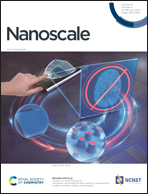Oxidase-like manganese oxide nanoparticles: a mechanism of organic acids/aldehydes as electron acceptors and potential application in cancer therapy†
Abstract
Identifying the underlying catalytic mechanisms of synthetic nanocatalysts or nanozymes is important in directing their design and applications. Herein, we revisited the oxidation process of 4,4′-diamino-3,3′,5,5′-tetramethylbiphenyl (TMB) by Mn3O4 nanoparticles and revealed that it adopted an organic acid/aldehyde-triggered catalytic mechanism at a weakly acidic or neutral pH, which is O2-independent and inhibited by the pre-addition of H2O2. Importantly, similar organic acid/aldehyde-mediated oxidation was applied to other substrates of peroxidase in the presence of nanoparticulate or commercially available MnO2 and Mn2O3 but not MnO. The selective oxidation of TMB by Mn3O4 over MnO was further supported by density functional theory calculations. Moreover, Mn3O4 nanoparticles enabled the oxidation of indole 3-acetic acid, a substrate that can generate cytotoxic singlet oxygen upon single-electron transfer oxidation, displaying potential in nanocatalytic tumor therapy. Overall, we revealed a general catalytic mechanism of manganese oxides towards the oxidation of peroxidase substrates, which could boost the design and various applications of these manganese-based nanoparticles.



 Please wait while we load your content...
Please wait while we load your content...